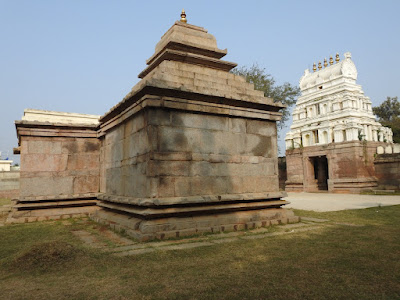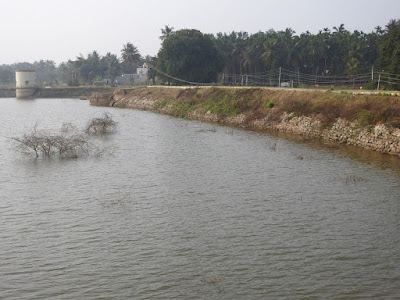...continued from Gangadareshwara Devalaya, Gulur. Our next stop i.e. Kaidala Chennakesava was just 2 km away, about 5 minute drive by car. Since the temple is on the outskirts, we did not enter Kaidala village. Around the temple is plenty of open space and trees. We parked the car under and headed towards the Gopura. Honestly I hadn't expected to see such a well maintained monument. Good work by the concerned government department and village people.
Sri Chennakesava Devalaya Gopura is a three tier tower, it's design is a fine example of Hoysala / Vijayanagara architecture. While the temple was constructed during Hoysala period, the Gopura was either constructed / renovated during the Vijayanagara period. Let's take a look at the historical information provided on the boards planted here by state govt.
Below are the transcriptions of Kannada and English boards by Tumakuru District Tourism Development Committee:
ಕೈದಾಳ : ಇದು ಅತ್ಯಂತ ಪ್ರಾಚೀನ ಚಾರಿತ್ರಿಕ ಸ್ಥಳವಾಗಿದೆ. ಇಲ್ಲಿ ಹೊಯ್ಸಳ ದೊರೆ ಮೊದಲನೇಯ ನರಸಿಂಹನ ಸಾಮಂತ ಗೂಳಿಬಾಚಿದೇವನು ಕ್ರಿ.ಶ.1150 ರಲ್ಲಿ ನಿರ್ಮಿಸಿದ ಗಂಗಾಧರೇಶ್ವರ, ರಾಮೇಶ್ವರ ಮತ್ತು ಚನ್ನಕೇಶವ ದೇವಾಲಯಗಳಿವೆ. ಪಶ್ಚಿಮಾಭಿಮುಖವಾಗಿರುವ ಚನ್ನಕೇಶವ ದೇವಾಲಯದ ಗರ್ಭಗುಡಿಯಲ್ಲಿ 167.64 ಸೆ.ಮಿ. ಎತ್ತರದ ಸುಂದರವಾದ ಚನ್ನಕೇಶವ ಮೂರ್ತಿಯು ಗರುಡ ಪೀಠದ ಮೇಲಿದೆ. ಪೀರದಮೇಲೆ, ತ್ರಿಮೂರ್ತಿ-ಬ್ರಹ್ಮ, ವಿಷ್ಣು ಮತ್ತು ಮಹೇಶ್ವರರ ಶಿಲ್ಪಗಳಿವೆ. ಇಕ್ಕೆಲಗಳಲ್ಲಿ ಶ್ರೀದೇವಿ ಮತ್ತು ಭೂದೇವಿಯರ ಸುಂದರವಾದ ಶಿಲ್ಪಗಳಿವೆ. ಮಕರ ಸಂಕ್ರಾಂತಿಯ ದಿನ ಸೂರ್ಯಾಸ್ತದ ಕಿರಣಗಳು ಕೇಶವನ ಎದುರಿಗಿರುವ ಗರುಡಮೂರ್ತಿಯ ಕಿವಿಯ ಕೆಳಭಾಗದಿಂದ ಮುಖ್ಯ ದೇಗುಲದ ಗೋಡೆಯಲ್ಲಿನ ಎರಡು ರಂಧ್ರಗಳ ಮೂಲಕ ದೇಗುಲದ ಒಳಕ್ಕೆ ಪ್ರವೇಶಿಸಿ ಚನ್ನಕೇಶವ ಮೂರ್ತಿಯ ಪಾದವನ್ನು ಸ್ಪರ್ಶಿಸುವಂತೆ ನಿರ್ಮಿಸಿರುವುದು ಈ ದೇವಾಲಯದ ವಾಸ್ತು ವಿಶೇಷವಾಗಿದೆ. - ಜಿಲ್ಲಾಧಿಕಾರಿಗಳು ಹಾಗೂ ಅಧ್ಯಕ್ಷರು, ಜಿಲ್ಲಾ ಪ್ರವಾಸೋದ್ಯಮ ಅಭಿವೃದ್ಧಿ ಸಮಿತಿ ತುಮಕೂರು ಜಿಲ್ಲೆ.
Kaidala: It is a very ancient historical place. Here there are Gangadhareshwar, Rameshwar and Channakesava temples built in 1150 AD by Gulibachideva, a colon of the first Hoysala ruler Narasimha. 167.64 cm in the sanctum sanctorum of Channakesava temple facing west. A tall and beautiful idol of Channakesava stands on the Garuda Peetha. On the pedestal, there are sculptures of Trimurti- Brahma, Vishnu and Maheswara. Both have beautiful sculptures of Sridevi and Bhudevi. The special feature of this temple is that the sunset rays of Makar Sankranti enter the temple through two holes in the wall of the main temple from the bottom of the ear of the Garudamurthy in front of Keshava and touch the feet of Channakesavamurthy. - Deputy Commissioner and Chairman, District Tourism Development Committee, Tumakuru District.
Below is the transcription of the board planted by the Department of Archaeology Museums & Heritage:
ಶ್ರೀ ಚೆನ್ನಿಗರಾಯ ದೇವಾಲಯ, ಕೈದಾಳ, ತುಮಕೂರು
ಕೈದಾಳಕ್ಕೆ ಕ್ರೀಡಾಪುರವೆಂಬ ಹೆಸಡಿತ್ತು. ಇದು ಶಿಲ್ಪಿ ಜಕವಾಚಾರಿಯ ಜನ್ಮ ಸ್ಥಳ ಎನ್ನಲಾಗಿದೆ. ಚಿಕ್ಕಸಿಕಾರಿಯ ಮಗ ಸಂಕಣಾಚಾರಿ ಬೇಲೂರು ಚೆನ್ನಿಗರಾಯ ಮೂತಿಯಲ್ಲಿ ದೋಷವನ್ನು ಕಂಡು ಅದನ್ನು ತೋರಿಸಿದಾಗ ಜಕಣಾಚಾರಿ ತನ್ನ ಬಲಗೈಯನ್ನು ಕತ್ತರಿಸಿಕೊಂಡ, ಅನಂತರ ತನ್ನ ಹುಟ್ಟೂರಾದ ಕೈದಾಳಕ್ಕೆ ಬಂದು ಅಲ್ಲಿ ಚೆನ್ನಿಗರಾಯನ ದೇವಾಲಯ ನಿರ್ಮಿಸಲು, ಜಕಣಾಚಾರಿಗೆ ಪುನಃ ಕೈ ಬಂತು. ಆದ್ದರಿಂದ ಆ ಊರಿಗೆ ಕೈದಾಳವೆಂಬ ಹೆಸರಾಯಿತು ಎಂದು ಐತಿಹ್ಯವಿದೆ. 1150-51ಲ್ಲಿ ಹೊಯ್ಸಳ ೧ನೆಯ ನರಸಿಂಹನ ಸಾಮಂತನಾಗಿದ್ದ ಬಾಚಿ ಅಥವಾ ಗೂಳಿಬಾಚಿ ಎಂಬುವನು ಇಲ್ಲಿ ಶಿವ, ವಿಷ್ಣು ಮತ್ತು ಜಿನ್ ದೇವಾಲಯಗಳನ್ನು ಕಟ್ಟಿಸಿದನೆಂದು ಇಲ್ಲಿನ ಒಂದು ಶಾಸನದಿಂದ ತಿಳಿದುಬರುತ್ತದೆ. ಈಗ ಚೆನ್ನಕೇಶವ ಮತ್ತು ಗಂಗಾಧರೇಶ್ವರ ದೇವಾಲಯುಗಳು ಮಾತ್ರ ಉಳಿದಿವೆ.
ಚೆನ್ನಕೇಶವ ದೇವಾಲಯ ದ್ರಾವಿಡ ವಾಸ್ತುಶೈಲಿಯಲ್ಲಿದೆ. ಮೂಲತಃ ಇದು ಹೊಯ್ಸಳ ಕಾಲದ ದೇವಾಬದುವಾಗಿದ್ದರೂ ಅನಂತರದ ಕಾಲಗಳಲ್ಲಿ ಬಹುವಾಗಿ ನವೀಕೃತವಾಗಿರುವಂತೆ ತೋರುತ್ತದೆ. ದೇವಾಲಯದ ಮಹಾದ್ವಾರದ ಮೇಲಿನ ಗೋಪುರ ವಿಜಯನಗರ ಕಾಲದಲ್ಲಿ ನಿರ್ಮಿತವಾದದ್ದು, ಚೆನ್ನಿಗರಾಯನ ಮೂಲವಿಗ್ರಹ ಬಹು ಸುಂದರವಾಗಿದೆ. ವಿಗ್ರಹ 5.1 ಅಡಿ ಎತ್ತರವಿದ್ದು 2.1 ಅಡಿ ಎತ್ತರದ ಪೀಠದ ಮೇಲೆ ಸ್ಥಾಪಿತವಾಗಿದೆ. ವಿಗ್ರಹದ ಪ್ರಭಾವಳಿಯಲ್ಲಿ ದಶಾವತಾರದ ಚಿತ್ರಗಳಿವೆ. ಮಹಾದ್ವಾರದ ಬಲಬದಿಯ ಕಂಬವೊಂದರ ಮೇಲೆ ಪತ್ನಿಸಹಿತವಿರುವ ಚೆನ್ನಕೇಶವನ ವಿಗ್ರಹವಿದೆ. ಎಡಗಡೆಯ ಕಂಬದ ಮೇಲೆ ಅಂಜಲಿಬದ್ದನೂ ಉತ್ತರೀಯಧಾರಿಯೂ ಖಡ್ಗಭೂಷಿತನ ಆದ ಮೂರ್ತಿಯನ್ನು ಕೆತ್ತಲಾಗಿದೆ. ಇದು ಜಕಣಾಚಾರಿಯ ಶಿಲ್ಪ ಎಂದು ಐತಿಹ್ಯ. ಆದರೆ ಇದು ಗೂಳಿ ಬಾಚಿಯ ಮೂರ್ತಿಯಾಗಿರುವ ಸಂಭಾವ್ಯತೆ ಇದೆ.
ಆಯುಕ್ತರು ಪ್ರಾಚ್ಯವಸ್ತು ಸಂಗ್ರಹಾಲಯಗಳು ಮತ್ತು ಪರಂಪರೆ ಇಲಾಖೆ, ಮೈಸೂರು.
Sri Chennigaraya temple, Kaidal, Tumkur
Kaidal was known as Kreedapura, it is said to be the birthplace of sculptor Jakanachari when Jakanachari's son Dankanachari found a defect in the idol of Belur Chennigaraya and showed Jakanachari cut off his own right hand, then came back to his hometown Kaidala and built the temple of Chennigaraya, he regot his cut-off hand. Afterwards legend he says that the town became known as Kaidala.
One inscription shows that Bachi or Gulibachi, a Kaidala ruler of Hoysala Narasimhai built the shrines of Shiva, Vishnu and Jina in 1150-51 CE. Now only the Chennakesava and Gangadhareshwara temples remain.
Chennakeshava temple is in Dravidian architectural style although originally a temple of the Hoysala period, it seems to have been largely renovated in later times. The tower on the temple main gateway was built during the Vijayanagara period and the original idol Chennigaraya is very attraction. The idol is 5.1 feet high and is installed on a 2.1 feet high pedestal. There are idol of Dasavatara in the Prabahavali of the image on one of the pillars on the right side of the gateway is a idol of Chennakeshava, who is with wife. On the pillar of the left side idol is a darned with Uttanga sword and folded palms itis said to be sculpture of Jakanachari but it has the possibility to be the idol of Gulibachi.
Commissioner, Dept. of Archaeology Museums & Heritage, Mysore.
The first writeup seems to be erroneous, looks like it wasn't proofread prior to inscribing it in stone. The second writeup has interesting information, particularly the story of Jakanachari regrowing hands.
Below is a collage of pictures of the columns in the doorframe of the Gopura. The columns feature a pair of beautiful girls in a graceful pose, flowery creepers and imaginary creature. The girls, adorned in jewelry from head to toe, are standing on Yali, the imaginary creature. Going by the looks of the sculptures, one can say these are Vijayanagara time creations.
Here's another collage showing the two middle columns inside the Gopura. Lord Vishnu and Garuda adorn one of the pillars. The other pillar has a stout well built male figure, no idea who it is. At the pillar base is a Yali.
The inner side of the Gopura. The base of the Gopura i.e. the stone walls have some interesting sculptures... men of horses and camels. elephants and fishes.
The elephants on the right hand side wall look like they are in a stable. Coming to the fishes, two large fish are competing each other for a smaller fish.
The left hand side has a pair of Yali, a fish, and the third sculpture seems like a lion. Then we have what seems like a procession of important people. The procession is led by a footman, followed by warriors on decorated horses. The troupe ends with a camel, it isn't clear if the rider is a man or woman.
A diagonal view of the Gopura. That's a Banni tree, an important plant in Hindu traditions.
The temple's rear view. The Shikhara seems to be Vimana type. The walls are plain and simple, not like the heavily sculpted exteriors of other Hoysala temples seen in Tumkur district.
In my tours, I have rarely seen a Shikhara and Gopura of the same temple in good condition. One must appreciate the efforts of local people in maintaining this temple's cleanliness.
This is the rear door, placed on the southern side of the temple. Even though the temple's main entrance is north-facing, the sanctum is west-facing which is quite rare.
Coming to the western side, there's a smaller temple dedicated to Garuda, Vishnu's vehicle.
The temple is unique. It's basically a sanctum with a wide Mukhamantapa. The deity, Garuda Murti is about 3' tall (see inset). Also in front of this little temple is a stubby little pillar.
Next to Garuda Devastana is a small mantapa which is fused into the compound wall. The mantapa's stage is elevated. This could be a stage for special occasions like weddings or birthdays.
Next to the little mantapa is the Banni Mara, almost in the northwestern corner of the temple premises. Under the Banni tree are two ancient sculptures. The horizontal one is Saptamatrika and the vertical slab is a memorial stone. The former is broken into two pieces. The latter is in memory of two lady warriors. The lowest panel shows one of the warriors armed with a bow. The middle panel shows fairies accompanying the two warriors. Between the lower and middle panels is and inscription. In the upper panel, the two warriors have merged into Shivalinga.
Lastly coming to the temple's main entrance.. the elephant balustrade is an interesting creation. If you ignore the trunk, you'll be looking at a boar. Well, that's my imagination, may not be the sculptor's intention to create an illusion.
Since the temple door was closed we hadn't seen the interior. We had moved on to see the neighboring temple Gangadareshwara Devalaya which too was closed. A group of seven or eight people had come to see Chennakesava Devalaya, apparently they had requested the poojari for a darshan. Fortunately for us, we got an opportunity to see Chennakesava Murti. The idol is an amazing piece of art, decorated with fresh flowers and glittering jewels. I was captivated by the shimmering diamonds as the poojari did arti... the warm light from oil lamp reflecting off the gems was a sight to behold. No photography inside, so no pictures of the interior.
The four wheels must belong to the temple chariot. I do not remember seeing the 'Theru' here, maybe I missed it. On the Gopura outer walls are relief sculptures of battle... two swordsmen, elephants charging at each other and horses leaping. Also a group of musicians are shown in niches.
A stone's throw from the Gopura is an small incomplete temple. On it's front walls are two relief sculptures of Vishnu.
That's it about Chennakesava Devalaya. Right in front of the temple is a 30+ acre plot under the state forest department. The gates were open, I went in with a hope of seeing Krishna Ficus. I searched the part closer to the gates, around the pergola but no such luck. One of the local guy who hung around with me out of curiosity, I showed him a picture of Krishna Ficus leaves on my mobile phone. He doesn't remember seeing any cup-shaped leaf here but he did say that this was a large area to check. I aborted the search since it was getting warm and we wanted to reach Bhogasandra by noon.
When I started this post, I realized missing out Rameshwara Devalaya at Kaidala. I'll have to make another trip a week or two after Ganesh Chaturti to see the making of Maha Ganapati at Gulur, and also visit Rameshara Gudi at Kaidala.

























































